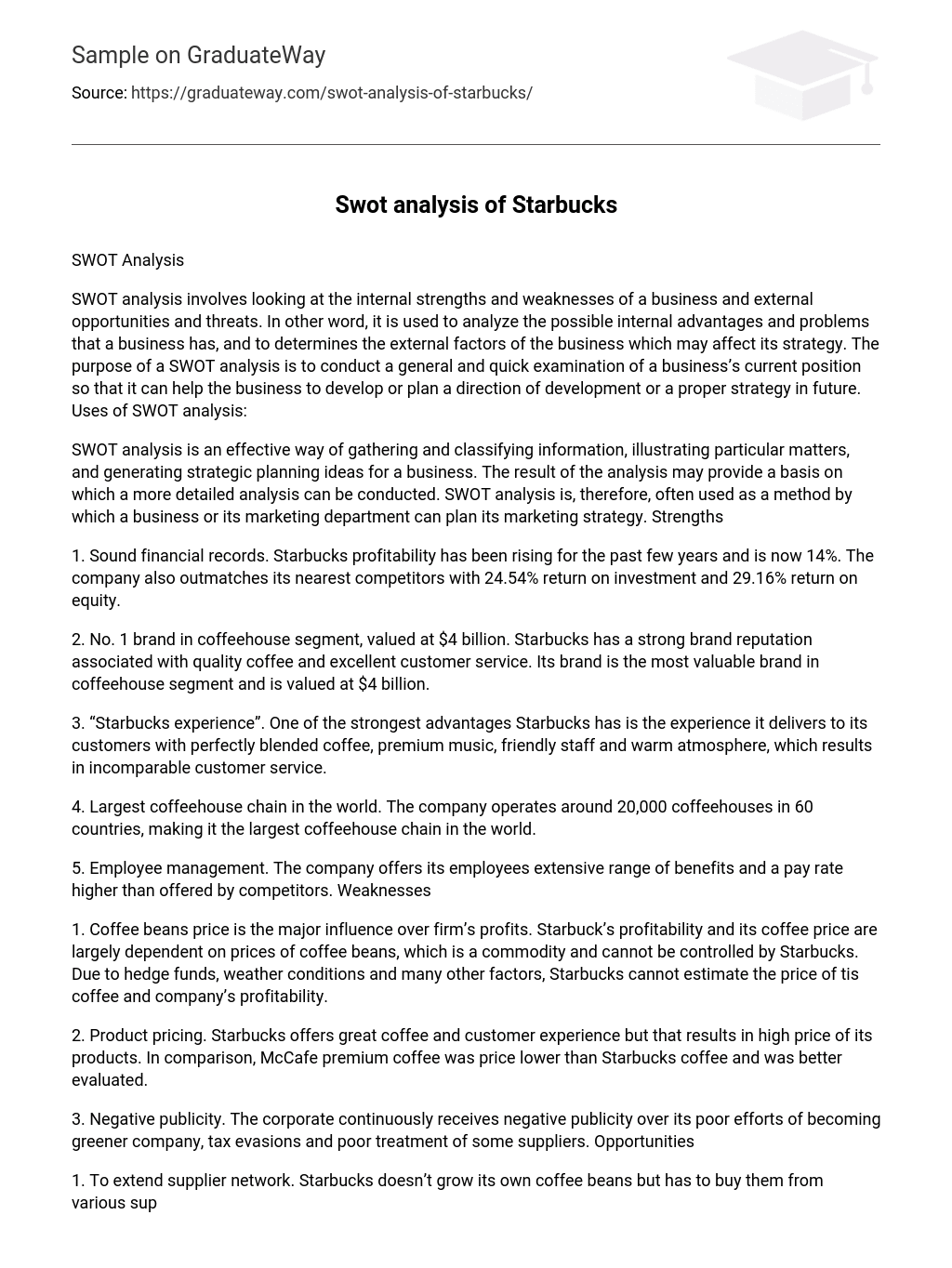SWOT Analysis
SWOT analysis involves looking at the internal strengths and weaknesses of a business and external opportunities and threats. In other word, it is used to analyze the possible internal advantages and problems that a business has, and to determines the external factors of the business which may affect its strategy. The purpose of a SWOT analysis is to conduct a general and quick examination of a business’s current position so that it can help the business to develop or plan a direction of development or a proper strategy in future. Uses of SWOT analysis:
SWOT analysis is an effective way of gathering and classifying information, illustrating particular matters, and generating strategic planning ideas for a business. The result of the analysis may provide a basis on which a more detailed analysis can be conducted. SWOT analysis is, therefore, often used as a method by which a business or its marketing department can plan its marketing strategy. Strengths
1. Sound financial records. Starbucks profitability has been rising for the past few years and is now 14%. The company also outmatches its nearest competitors with 24.54% return on investment and 29.16% return on equity.
2. No. 1 brand in coffeehouse segment, valued at $4 billion. Starbucks has a strong brand reputation associated with quality coffee and excellent customer service. Its brand is the most valuable brand in coffeehouse segment and is valued at $4 billion.
3. “Starbucks experience”. One of the strongest advantages Starbucks has is the experience it delivers to its customers with perfectly blended coffee, premium music, friendly staff and warm atmosphere, which results in incomparable customer service.
4. Largest coffeehouse chain in the world. The company operates around 20,000 coffeehouses in 60 countries, making it the largest coffeehouse chain in the world.
5. Employee management. The company offers its employees extensive range of benefits and a pay rate higher than offered by competitors. Weaknesses
1. Coffee beans price is the major influence over firm’s profits. Starbuck’s profitability and its coffee price are largely dependent on prices of coffee beans, which is a commodity and cannot be controlled by Starbucks. Due to hedge funds, weather conditions and many other factors, Starbucks cannot estimate the price of tis coffee and company’s profitability.
2. Product pricing. Starbucks offers great coffee and customer experience but that results in high price of its products. In comparison, McCafe premium coffee was price lower than Starbucks coffee and was better evaluated.
3. Negative publicity. The corporate continuously receives negative publicity over its poor efforts of becoming greener company, tax evasions and poor treatment of some suppliers. Opportunities
1. To extend supplier network. Starbucks doesn’t grow its own coffee beans but has to buy them from various suppliers, which are mainly clustered in South America, Arabia or Africa. For Starbucks to ensure critical supplies for its operations in Asia, reduce the dependence of good or bad harvests in Africa and South America and to save on shipping costs, Starbucks has to extend its supplier network.
2. Expansion to emerging economies. There are great opportunities for coffeehouses in China and India, in which Starbucks has comparably only modest number of restaurants.
3. Increase product offerings. The business could expand the number of coffeehouses that offer wine and beer, plus adding some new products and reaching broader customer group.
4. Expansion of retail operations. Starbucks does not only manage coffeehouses and franchises but sells some of its products through other retailers. The firm should form more of such partnerships and offer to sell its coffee, for example, in supermarkets.
Threats
1. Rising prices of coffee beans and dairy products. The chain strongly depends on the coffee beans and dairy products prices, which Starbucks cannot control or can hardly estimate.
2. Trademark infringements. The company is often involved in cases over illegal use of its trademark, which is costly and detrimental for Starbucks.
3. Increased competition from local cafes and specialization of other coffeehouse chains. Local cafes can offer much lower price and more suited menu for its customer. Big coffeehouse chains specialize so they wouldn’t need to compete head-to-head with Starbucks. In both situations, Starbucks experiences intense competition and loses market share.
4. Saturated markets in the developed economies. Coffee markets in the developed economies are already saturated and with intensifying competition, Starbucks will find it hard to grow in these markets.
5. Supply disruptions. Due to political, economic and weather conditions Starbucks may experience supply disruptions, adding significant cost to the firm.





